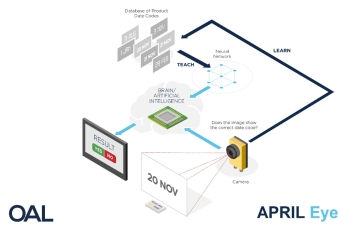
World’s First AI-based date-code scanner
January 10, 2019
By Bakers Journal
 Image courtesy of OAL
Image courtesy of OALFood-tech company OAL announced the formal launch of the world’s first artificial intelligence-based vision system, APRIL Eye, for date code verification.
The system removes the operator from the date code verification process, achieving full automation to reduce the risk of product recalls and emergency product withdrawals (EPWs) caused by human error on packaging lines. It can reach speeds of over 300 packs a minute, and can make a significant improvement to processes, safety, quality and efficiency and deliver cost savings to food and beverage manufacturers on their packaging lines.
By combining machine learning and artificial intelligence, APRIL Eye transforms the traditional date code verification process, which relies on operators to check the date code is printed correctly. APRIL Eye removes the human error inherent in these boring, repetitive tasks. By taking photos of each date code, the system can read them back using scanners to ensure they match the programmed date code for that product run, fully automating the verification process and allowing food and beverage manufacturers to achieve unmanned operations and full traceability. Running at speeds of over 300 packs a minute, it also allows them to increase throughput without compromising product safety. The production line comes to a complete stop if a date code doesn’t match, ensuring that no incorrect labels can be released into the supply chain, protecting consumers, margins and brands.
Traditional vision systems have relied on optical character recognition (OCR), designed to read specific characters. Due to the prevalence of inkjet printers in the food industry, which have a higher degree of variability, these vision systems have not been widely implemented. OAL therefore developed APRIL Eye, which uses basic cameras backed up with an artificial brain to deliver a vision system that can deal with variations such as lighting, positioning, print quality and placement inherent in a food or beverage plant and read anything that is also legible to the naked eye. In this way, APRIL Eye eliminates errors, offers full traceability and protects consumers and the brand while at the same time reducing labour costs and waste. The system also improves over time, further safeguarding manufacturers.
APRIL Eye stemmed from an initiative led by a large retailer to eliminate food waste in the supply chain by preventing human error. Incorrect date codes and packaging was found to be one of the largest sources of food waste; a $60-80 million problem (excluding energy and environmental impact).
OAL spearheaded the development as part of its Food Manufacturing Digitalization Strategy, supported by the University of Lincoln and Innovate UK grant funding, designed to investigate how artificial intelligence could revolutionize this key area of the food manufacturing process. The University of Lincoln put together a team of global experts in AI, including Professor Stefanos Kollias, the founding professor of machine learning, to develop the APRIL Eye solution. The system was first deployed with two leading global manufacturers and has since been rolled out across existing OAL Connected customers, with no EPWs related to date code errors to date.
Print this page
Leave a Reply